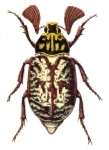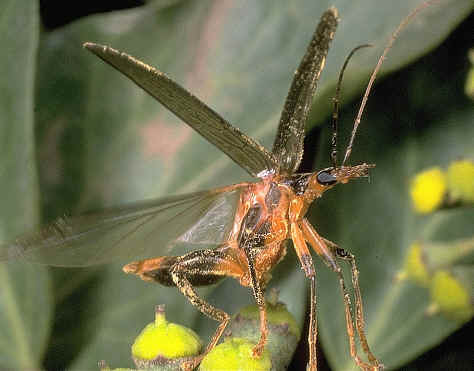|
|
|
|
 |

|
|
chafers etc. (Scarabaeoidea) |
darkling beetles (Tenebrionidae) |
|
__________________________________________________________________________________________________________
THE FALSE BLISTER BEETLES (COLEOPTERA OEDEMERIDAE) OF THÁSOS
 Vázquez
(2002) records 45 species of Oedemeridae from Greece. Twenty-nine species are
shown as occurring in north-east Greece but it is not possible from
his maps to determine how many species have been reported from Thásos. The only
records
previously published for Thásos appear to be those of Karnozickij (1959), who
recorded five species from the island in May 1943. These include 'Chrysanthia
viridis', which is likely to refer to C. varipes (X.A. Vázquez,
pers. comm.) but the record needs confirmation. My own collecting has
added five more species to the island list (asterisked below) and I am grateful to Dr Brian Levey for help with identification. The species recorded so far from Thásos are all widespread in Greece and most are also widely distributed
throughout Europe, although Oedemera rufofemorata,
and Anogcodes seladonius turcicus are south-eastern species
restricted to the Balkan region and extending further east. Vázquez
(2002) records 45 species of Oedemeridae from Greece. Twenty-nine species are
shown as occurring in north-east Greece but it is not possible from
his maps to determine how many species have been reported from Thásos. The only
records
previously published for Thásos appear to be those of Karnozickij (1959), who
recorded five species from the island in May 1943. These include 'Chrysanthia
viridis', which is likely to refer to C. varipes (X.A. Vázquez,
pers. comm.) but the record needs confirmation. My own collecting has
added five more species to the island list (asterisked below) and I am grateful to Dr Brian Levey for help with identification. The species recorded so far from Thásos are all widespread in Greece and most are also widely distributed
throughout Europe, although Oedemera rufofemorata,
and Anogcodes seladonius turcicus are south-eastern species
restricted to the Balkan region and extending further east.
Oedemerids are comparatively large beetles (mainly around 10mm in length) and
are conspicuous on flowers during the day in early to mid summer. Some species
have enlarged hind femora (giving rise to the name 'thick-legged flower
beetles') whilst others have curiously shaped elytra partially exposing the
hindwings. With their elongate antennae and narrow elytra they resemble small
longhorn beetles. The larvae of most species develop within rotten spongy wood
of dead conifers and broad-leaved trees, but some species occur within the dead
stems of herbaceous plants. Oedemerids contain the toxin cantharadin within
their body fluids as a chemical defense mechanism, like the oil beetles to which
they are closely related, and handling them can cause prominent blisters on the
skin.
Identification of all European species of Oedemerids is now possible with the
publication by Vázquez (2002), which includes distribution maps and colour illustrations of all
taxa.
CHECKLIST
Anogcodes
ruficollis (F.)*
Anogcodes
seladonius turcicus (W. Schmidt)*
Anogcodes
ustulatus (Scopoli)*
Chrysanthia cf. varipes
(Keisenwetter)
Oedemera crassipes Ganglbauer, 1881*
Oedemera femorata
(Scopoli)
Oedemera flavipes
(F.)
Oedemera lurida
(Marsham)
Oedemera
rufofemorata Germar
Opsimea ventralis
Miller*
REFERENCES
Karnozickij, N. 1959. Materialien zur Koleopteren-Fauna der Agäischen Küste
und Insel Thasos. Izv. zool. Inst. Sof., 8: 237-253.
Vázquez, X.A.
2002. European Fauna of Oedemeridae. Barcelona, Arganio Editio.
|

















 Vázquez
(2002) records 45 species of Oedemeridae from Greece. Twenty-nine species are
shown as occurring in north-east Greece but it is not possible from
his maps to determine how many species have been reported from Thásos. The only
records
previously published for Thásos appear to be those of Karnozickij (1959), who
recorded five species from the island in May 1943. These include 'Chrysanthia
viridis', which is likely to refer to C. varipes (X.A. Vázquez,
pers. comm.) but the record needs confirmation. My own collecting has
added five more species to the island list (asterisked below) and I am grateful to Dr Brian Levey for help with identification. The species recorded so far from Thásos are all widespread in Greece and most are also widely distributed
throughout Europe, although Oedemera rufofemorata,
and Anogcodes seladonius turcicus are south-eastern species
restricted to the Balkan region and extending further east.
Vázquez
(2002) records 45 species of Oedemeridae from Greece. Twenty-nine species are
shown as occurring in north-east Greece but it is not possible from
his maps to determine how many species have been reported from Thásos. The only
records
previously published for Thásos appear to be those of Karnozickij (1959), who
recorded five species from the island in May 1943. These include 'Chrysanthia
viridis', which is likely to refer to C. varipes (X.A. Vázquez,
pers. comm.) but the record needs confirmation. My own collecting has
added five more species to the island list (asterisked below) and I am grateful to Dr Brian Levey for help with identification. The species recorded so far from Thásos are all widespread in Greece and most are also widely distributed
throughout Europe, although Oedemera rufofemorata,
and Anogcodes seladonius turcicus are south-eastern species
restricted to the Balkan region and extending further east.